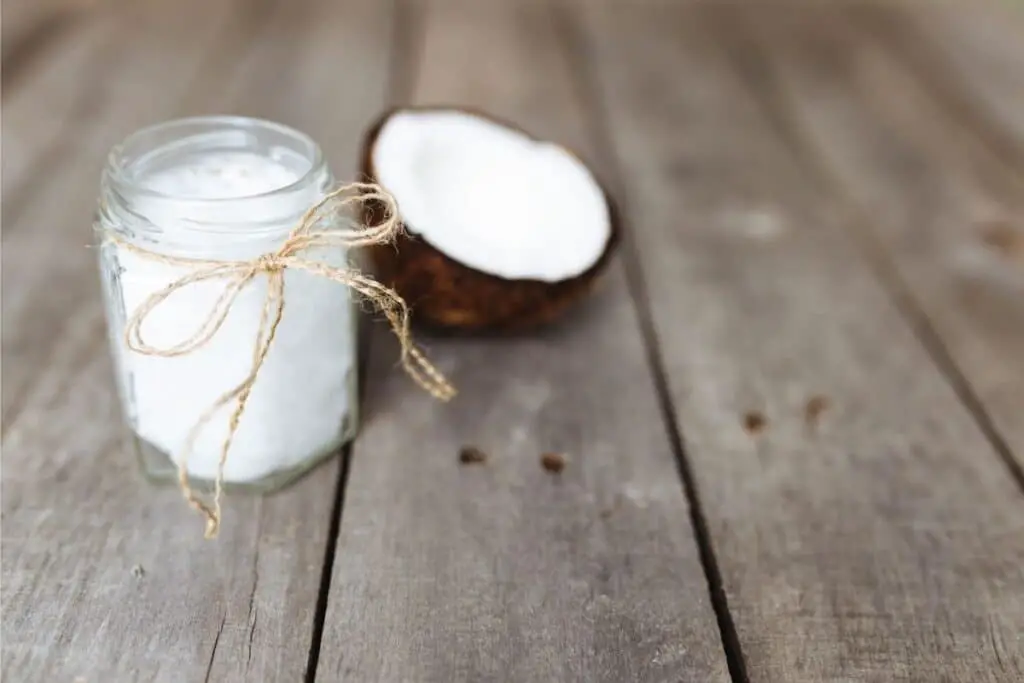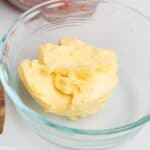In short, the best alternatives to coconut oil include avocado oil, butter, extra virgin olive oil, Canola, etc. I will explain how to use each substitute and offers suggestions for when they are most appropriate.
Although coconut oil was previously associated with vegan cooking, it is no longer only available in health food stores. It has become a popular addition in all types of recipes including non-vegan dishes and is a versatile addition to the pantry since it doubles as a cosmetic product with great benefits for skin and hair.
This multipurpose ingredient is used in sweet and savory dishes, cooked, raw, hot, and cold.
If your recipe calls for coconut oil and you’re all out or don’t generally cook with it, you’ll need a substitute. It can be pricey and purchasing an entire tub when you only need a couple of tablespoons may not be worth your while.
Here, we’ll help you choose the best coconut oil substitutes according to the dish you are preparing. You will likely have at least one of the below replacement options in your pantry already.
Coconut Oil in Cooking
Coconut oil (also referred to as coconut butter) is made from the meat, milk, and wick of a coconut. At cooler temperatures, it is a solid fat with white color. When warmed to around 78°F it starts to melt into clear liquid oil.
It has a coconut flavor with unrefined coconut oil presenting a stronger coconut taste than refined coconut oil.
Cold coconut oil can be used in its solid form for vegan baking, making raw health bars, cookies, frosting, cakes, and desserts.
With a smoke point of 350°F, melted coconut oil is also suitable for frying, deep frying at mid-temperature, sauteing, roasting, making sauces, and grilling.
What is Coconut Oil Smoke Point?
The smoking point is the temperature at which the fat or oil will start to smoke. Once it starts smoking chemical changes occur and the fat components start breaking down. If you use an oil with a low smoke point when cooking at high temperatures, it will bring a bitter taste to the food.
Generally, smoke points range between 325˚F and 520˚F. Since impurities and free fatty acids can cause smoking as well, you will notice that refined oils have a higher smoke point than unrefined oils and are best for frying and cooking at high temperatures.
Best Coconut Oil Substitutes
When choosing a substitute for coconut oil consider whether it is used as a solid or liquid in the recipe and whether the flavor of the substitute will influence or change the taste of your dish.
1. Avocado Oil
Although not the cheapest option, avocado oil is our top choice as the best coconut oil substitute when sauteing, stir-frying, and roasting. It has a very high smoke point which means it’s ideal for cooking at high temperatures.
Avocado oil has a neutral taste so although it won’t bring any hints of coconut, it won’t change the flavor of your recipe.
Since it is a pricy product, you probably won’t want to substitute avocado oil in large quantities for deep frying, although it is suitable to use as a replacement in almost any application in equal quantities.
2. Butter
Like coconut oil, butter is solid (yet spreadable) at room temperature and melts to a runny, light yellow liquid when heated. Usually churned from cow milk or cream, it consists of around 80% butterfat.
Butter comes in salted and unsalted versions. When using it as a replacement, opt for the unsalted type. If you don’t need a vegan coconut oil alternative, this is another top choice since it has a similar smoking point and can be used for anything from frostings, baking, and cookies, to sauces, basting, grilling, sauteing, and roasting.
Butter adds a delicious richness to any dish and enhances the texture of many baked goods. Use melted butter when your recipe calls for melted coconut oil and cold butter when your recipe requires a solid form. Substitute butter in equal quantities.
See more: Butter alternatives for baking
3. Extra Virgin Olive Oil
This plant-based oil has a low smoking point of only 210˚F. Therefore, it is not ideal for high heat cooking but rather for oven roasting and sauteing at low to medium heat. It is often drizzled over bread or vegetables and used in salad dressings.
Olive oil has a distinct taste that may be detectable in dishes with subtle flavors. This means it is best not used for baking since it will affect the taste of your baked goods significantly.
Less expensive types are often not pure and may be blended with another vegetable oil, however, these can also be used as a substitute. Substitute olive oil in equal quantities.
4. Grapeseed Oil
This is a great alternative with a neutral flavor which makes it ideal for cooking, roasting, and baking. In addition, it has a high smoke point of 420˚F which further enhances its versatility.
As its name suggests, it is made by pressing the seeds of grapes. If you have this in the pantry, your problem is solved. When using it as a substitute, replace coconut oil in equal quantities.
5. Canola
This substitute is often a go-to for many cooks in daily cooking since it is readily available and has a high smoke point between 400 and 450˚F. It is versatile for deep-frying, baking, roasting, grilling, and marinades.
The product is made from a rapeseed variety that is specifically bred to contain low erucic acid levels. The natural variety, in contrast, contains very high acid levels. The seeds are heated and rolled to extract the oil, after which the product is refined.
This substitute has a neutral taste that makes it suitable for sweet and savory recipes without affecting the flavor profile of your dish.
Although rapeseed and canola oil are both produced from a similar variety of plants, they are very different in their cooking properties.
Related: Substitute for canola oil
6. Sunflower Seed Oil
Another commonly available pantry stable, this vegetable oil is made by pressing sunflower seeds to extract their oils.
Refined sunflower oil, which is the most commonly available type, has a neutral flavor and high smoke point at 450˚F. This makes it ideal for almost all cooking of sweet and savory dishes including baking, sauteing, deep-frying, roasting, stir-frying, and grilling. The cold-pressed type has a slightly buttery and nutty taste.
7. Almond Oil
This coconut oil replacement is known not only for its use in cooking but also in beauty products for its skin-enhancing properties. When using this as an alternative, make sure that its nutty flavor pairs well with the other flavors of your recipe.
It is a good plant-based choice for baked goods, muffins, and cakes. Since it has a high smoke point it can also be used for frying, roasting, sauteing, and grilling.
8. Hemp Seed Oil
Hemp oil has a stronger taste than canola and grapeseed. It is best used in dishes that don’t need to be heated at very high temperatures as this may affect the flavor profile. It’s a good alternative to use in marinades, soups, and dips, as well as in smoothies.
9. Safflower Oil
This replacement can be integrated into equal measures and is another neutral-tasting option suitable for a wide variety of applications. With a high smoke point of 450˚F, it can be used for deep frying as well as baking and roasting.
10. Hazelnut Oil
This is a great choice for baking with its slightly sweet, nutty, and toasty flavor, although you will want to ensure that the prominent taste pairs well with the other flavors in your dish.
Use it in equal quantities in recipes that don’t require a very large amount. It has a good smoking point at 450˚F which makes it suitable for all types of stovetop and oven cooking from frying, and sauteing to grilling and roasting.
11. Beef Tallow
Beef tallow can be used in baked dishes but is also popularly used for roasting vegetables and even french fries. It has a high smoke point which makes it versatile for a range of other cooking methods too. As its name suggests, it is an animal-derived product and won’t be suitable for vegans.
What makes this a good substitute is that, similar to butter, it has a solid yet pliable consistency at room temperature and melts into a liquid form when heated.
Beef tallow may give some aroma during cooking but despite this, it has a very neutral flavor. This allows it to be used in sweet and savory dishes without affecting the flavor profile of the dish in a notable way.
12. Applesauce
If you are looking for a low-fat, low-calorie alternative for baking, applesauce is a great vegan and dairy-free option. It won’t be suitable for stovetop cooking or crispy baked items but is ideal for moist bakes such as cakes, quick bread, and muffins.
When using applesauce, keep in mind that it has a high moisture content. Therefore, you only want to use ¾ of the amount required in the recipe to prevent your batter from becoming too runny.
You can also combine applesauce with an alternative oil to reduce calories but still have some degree of fat. If the batter looks runnier than usual, reduce some of the other liquids in the recipe or add a touch more flour to slightly thicken the consistency.
Opt for unsweetened applesauce or make apple puree yourself at home without adding any sugar as this can yield a sweeter dish than intended.
Simply peel and core the apples. Steam or cook them until tender and leave them to cool before giving them a good blitz in a food processor or blender to form a smooth puree.
Make sure to drain any excess moisture off the cooked apples before pureeing them to avoid an over the watery outcome.
You may be able to detect the change in flavor in baked goods with a subtle flavor, but generally, it is pleasant and pairs well with most desserts, muffins, brownies, and vegan bakes.
13. Cooking Spray
If you merely need something to grease a pan for cooking an omelet, sauteing onions, or baking, using cooking spray will do the trick. It only requires a thin layer to prevent sticking which can reduce the calories in your dish. With a neutral taste, it also won’t interfere with the other flavors in your recipe.
FAQ
Conclusion
Coconut oil is so versatile and great for making all kinds of delicious recipes from snack bars and Asian stir fry to cakes, curries, sauces, and vegan desserts. If you don’t have any on hand, there’s a variety of options to choose from ranging from vegan and non-vegan oils to fruit purees.
When choosing the best substitute for coconut oil consider whether your dish will be cooked at a high temperature. If this is the case, opt for something with a high smoke point, especially when frying. Also, consider if the product you choose has a prominent taste that could potentially alter the flavor profile of your dish.
With so many options available, you shouldn’t have any reason to not go ahead and cook up a storm! Happy cooking.
See more: How to tell if coconut oil is bad?
*image by PantherMediaSeller/depositphotos









